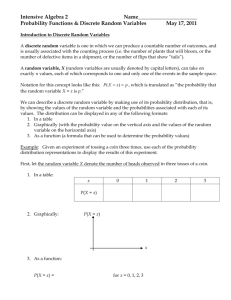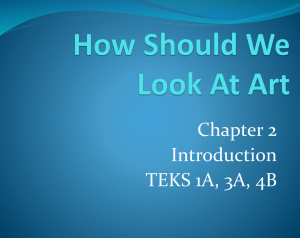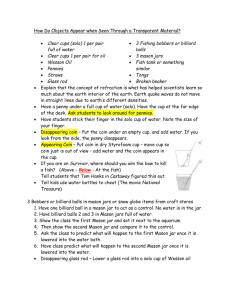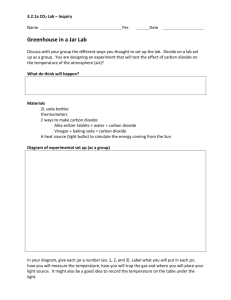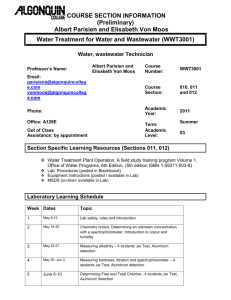Geometry
advertisement
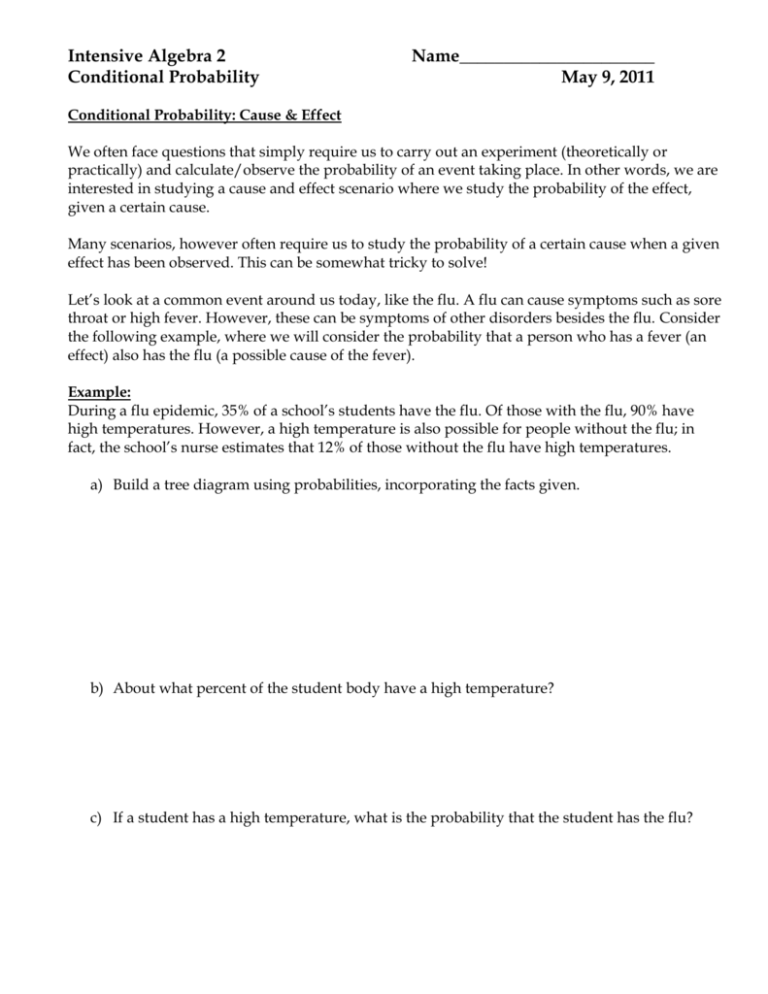
Intensive Algebra 2 Conditional Probability Name______________________ May 9, 2011 Conditional Probability: Cause & Effect We often face questions that simply require us to carry out an experiment (theoretically or practically) and calculate/observe the probability of an event taking place. In other words, we are interested in studying a cause and effect scenario where we study the probability of the effect, given a certain cause. Many scenarios, however often require us to study the probability of a certain cause when a given effect has been observed. This can be somewhat tricky to solve! Let’s look at a common event around us today, like the flu. A flu can cause symptoms such as sore throat or high fever. However, these can be symptoms of other disorders besides the flu. Consider the following example, where we will consider the probability that a person who has a fever (an effect) also has the flu (a possible cause of the fever). Example: During a flu epidemic, 35% of a school’s students have the flu. Of those with the flu, 90% have high temperatures. However, a high temperature is also possible for people without the flu; in fact, the school’s nurse estimates that 12% of those without the flu have high temperatures. a) Build a tree diagram using probabilities, incorporating the facts given. b) About what percent of the student body have a high temperature? c) If a student has a high temperature, what is the probability that the student has the flu? Intensive Algebra 2 Platt/Knaus Exercises: 1. A box contains 3 black cubes and 7 white cubes. A cube is drawn from the box (without replacement), its color noted, and a cube of the other color is then added to the box. A second cube is then drawn from the box. a. Draw a tree diagram illustrating the probabilities in this scenario b. What is the probability that the second cube selected is black? c. If we are given that both cubes drawn are of the same color, what is the probability that both cubes were white? 2. A fair coin, a double-headed coin, and a double-tailed coin are placed in a bag. A coin is randomly selected then tossed. a. Draw a tree diagram showing the possible outcomes b. Find the probability that the coin lands tails c. If we know that the coin flip shows heads, find the probability that it is the doubleheaded coin. Intensive Algebra 2 Platt/Knaus 3. Now we have a box containing N coins, of which m are fair coins, while the rest are doubleheaded coins. a. If a coin is selected at random and tossed…. i. What is the probability of observing a head? ii. Given that a head was observed, what is the probability that is was from a double-headed coin? b. This time, a coin is selected at random and tossed n times. What is the probability that is was a fair coin if heads was observed on all n tosses? Intensive Algebra 2 Platt/Knaus HW Exercises: 1) Use the tree diagram at the left below to find each probability. 0.4 X X' 0.3 Y 0.5 Y' Y Y' a) P( X ') b) P(Y ' | X ) c) P(Y ' | X ') d) P( X and Y ) e) P( X ' and Y ) f) P(Y ) g) P( X | Y ) h) P( X ' | Y ) 2) Five percent of the welds on an automobile assembly line are defective. The defective welds are found using an X-ray machine. The machine correctly rejects 92% of the defective welds and correctly accepts all of the good welds. a) Incorporate the facts given above into a tree diagram. b) What percent of welds are accepted by the machine? c) Find the probability that an accepted weld is defective. Intensive Algebra 2 Platt/Knaus 3) An auto insurance company charges younger drivers a higher premium than it does older drivers because younger drivers as a group tend to have more accidents. The company has 3 age groups: Group A includes those under 25 years old, 22% of all its policyholders. Group B includes those 25-39 years old, 43% of its policyholders. Group C includes those 40 years old or older. Company records show that in any given one-year period, 11% of its Group A policy holders have an accident. The percentages for groups B & C are 3% and 2%, respectively. a) What percent of the company’s policyholders are expected to have an accident during the next 12 months? b) Suppose Mr. X has just had a car accident. If he is one of the company’s policyholders, what is the probability that he is under 25? 4) Suppose you have two pair of dice. One pair is fair, but each die of the other pair is weighted so that a six comes up with the probability 1/4 instead of the probability 1/6. If you randomly choose one pair of dice, roll them, and obtain two sixes, what is the probability that you rolled the weighted dice twice? Intensive Algebra 2 Platt/Knaus 5) A medical research lab proposes a screening test for a disease. In order to try out this test, it is given to 100 people, 60 of whom are known to have the disease and 40 of whom are known not to have the disease. A positive test indicates the disease and a negative test indicates no disease. Unfortunately, such medical tests can produce two types of errors: (1) A false negative test: for the 60 people who do have, this screening test indicates that 2 do not have it. (2) A false positive test: for the 40 people who do not have the disease, this screening test indicates 10 do have it. a) Which of the false tests do you think is more serious? Why? b) Incorporate the facts given above into a tree diagram (make sure you are using probabilities). c) Suppose the test is given to a person not in the original group of 100 people. It is not known whether this person has the disease, but the test result is positive. What is the probability that the person really does have the disease? d) Suppose the test is given to a person whose disease status is unknown. If the test result is negative, what is the probability that the person does not have the disease? Intensive Algebra 2 Platt/Knaus 6) There are two jars (A and B), with red & white balls present in each. Jar A has 3 white balls and 2 red balls and jar B has 1 white ball and 4 red balls. Suppose that someone randomly picks one of the jars, but you don’t know which one. Before guessing which jar the “mystery jar” is, you have your choice of doing either of the following experiments. Experiment 1: Pick balls from the “mystery jar” and note their colors. Replace the first ball before choosing the second. Experiment 2: Pick two balls from the “mystery jar” and note their colors. Do not replace the first ball before choosing the second. 1/2 1/2 Jar A 2 reds 1 red, 1 white Jar B 2 whites 2 reds 1 red, 1 white 2 whites a) Complete the tree diagram for Experiment 1. b) Suppose you performed Experiment 1 and got 2 red balls. Then you would no doubt guess that they came from Jar B. Which jar would you guess if you got two white balls? 1 red ball and 1 white ball? What is the probability you would guess the correct jar if you performed the first experiment? Intensive Algebra 2 Platt/Knaus c) Make a tree diagram for Experiment 2. d) If you performed Experiment 2, which jar would you guess if you got 2 red balls? 2 white balls? 1 red and 1 white ball? What is the probability you would guess the correct jar if you performed the second experiment? e) Which experiment gives you the better chance of guessing correctly? f) Suppose a third experiment allows you to pick just one ball and then guess the jar. How likely are you to guess correctly in this experiment? Compare you answer with the probability of being correct in the first or second experiment. Are you surprised?
